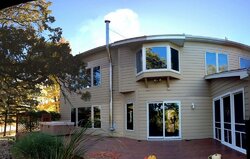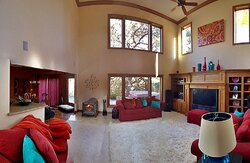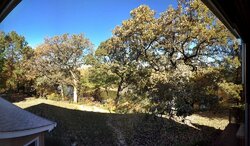I'm looking for some ideas to see what I can change or add to increase my draft. I originally installed a Woodstock Fireview 5 years ago. I added the stove to reduce propane useage. This house was built in 2000 with a lot of windows facing the wrong direction. We have 2x6 wall construction with adequate insulation - its just the amount of space we are heating and all of the windows which face N/NW and get a lot of wind in the winter.


Sometimes I have adequate draft, and other times I have negative draft. I used to warm the chimney regularly with a hair dryer before starting a fire. This was easy with the Fireview but not possible through the Progress Hybrid (PH). I can take the clean out cap off the bottom of the chimney but that is not really a good solution, especially in the middle of winter.
The PH uses a winding path through the stove to maximize the heat transfer from the smoke to the stove and increase efficiency and stove heat output. The design works VERY well and my house is much warmer than it was with the Fireview. However, this winding path is also a restriction, and with a poor draft, it is a problem for this installation. Here are some of the issues:
This house due to it's size will not be permanent for us, so I'm not looking to spend a lot of $. One of my thoughts is to add an outside air kit, but I really don't know if this will help or not? Thoughts?



Sometimes I have adequate draft, and other times I have negative draft. I used to warm the chimney regularly with a hair dryer before starting a fire. This was easy with the Fireview but not possible through the Progress Hybrid (PH). I can take the clean out cap off the bottom of the chimney but that is not really a good solution, especially in the middle of winter.
The PH uses a winding path through the stove to maximize the heat transfer from the smoke to the stove and increase efficiency and stove heat output. The design works VERY well and my house is much warmer than it was with the Fireview. However, this winding path is also a restriction, and with a poor draft, it is a problem for this installation. Here are some of the issues:
- When reloading, if I open the door all the way I usually get smoke spillage. Sometimes from the door, sometimes from the back side of the stove on the opposite end as the reloading door. This can be a lot of smoke on occasions.
- I get the smoke smell in the house. I did not have this problem with the Fireview and have replaced the door gasket twice with no change.
- Occasionally have wind problems (causing smoke spillage) which I suspect would be less with a better draft. This is much more likely to happen just after a reload, but on a very windy day, it has happened when the stove is running full out.
This house due to it's size will not be permanent for us, so I'm not looking to spend a lot of $. One of my thoughts is to add an outside air kit, but I really don't know if this will help or not? Thoughts?


